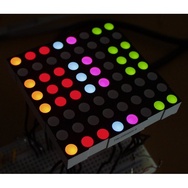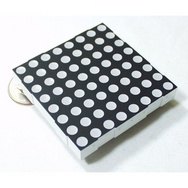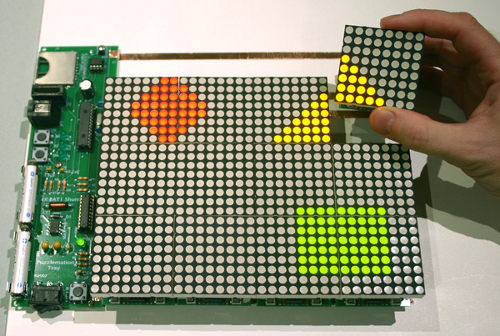So colorful....so very, very colorful.
We've been selling our LED matrices for a while now. They have been used in some cool projects, including our very own LED coffee table. The matrix is sold in dual color (small and medium) and tri-color (large). Fortunately, our version of the matrix is Keanu-free.
By now you're wondering, "Hey there buddy! What's your point?" My point is the above picture - a rad project from SparkFun customer John Peterson. You may have seen John at Maker Faire at some point and his Puzzlemation Project is incredibly cool. The picture doesn't do it justice - to see the project in all its glory, check out the video below.
Awe-some. Here's how John describes his project:
"Every time we look at computer screen, millions of pixels of light disappear into our work, our correspondence, or our entertainment. Imagine if you could capture those dots of light and scoop them up as you would grains of sand on the beach. Puzzlemation explores this idea, by dividing the digital display into pixels you're free to pick up and re-arrange. It can be used to create things as diverse as modular animated signs, to a uniquely challenging dynamic puzzle. It is a tool that lets you create animated light displays of any size and shape for whatever applications you can dream up."
Great work John!









This is awesome but kinda pricey.
He said he spent about $63 per tile cause of the contest deadline.
16 prototype tiles * $63 = $1,008
He said he could get it down to about $15 to $35 per tile, lets just say it is $20 per tile.
16 * $20 = $320 (plus the docking module)
How are the matrices powered when they are removed from the "dock"?
They have batteries.
Very nice, If each tile had a low power IR transceiver on each face it could tell which tiles it was next to and could change it's behaviour accordingly. I'm seriously tempted to make one but would probably use AVR's instead.
Yeah, wicked project I agree!
Hey while I'm here I was wondering if anything came of the cease and desist letter from SPARC International?
Google "Siftibles" - similar idea, but better!
That's a really cool idea - like those old school picture jumbles.
SPARKFUN
?Description: OpenLog is an open source data logger. Simple to use, simple to change. We wanted to create a serial logger that just worked. Power this device up and it will start logging any received serial data at 9600bps?
Datasheet (GITHUB)
?OpenLog is a simple serial logger based on the ATmega328 running at 16MHz. The ATmega328 should be able to talk to high capacity (larger than 2GB) SD cards. The whole purpose of this logger was to create a logger that just powered up and worked. OpenLog ships with a standard serial bootloader so you can load new firmware with a simple serial connection.?
I can?t get the darn thing to operate. I?m rather incompetent at some of this stuff . However, not just because of my incompetence, but also judging by the previous comments about the device, OpenLog is not as simple to get operating as stated.
PO?T
Please start selling these!!!!!
Next step, the video rubik's cube, can only solve it by paying attention to a ball bouncing around.
Now this is an awesome project. Great work! :)
That is so amazing,and it was skillfully made.
this is awesome
This is really cool!
My first thought was to change the animation after all the tiles are connected, but I see in the FAQ that the tiles don't communicate with each other.
Now this is really a fantasic project. The possibilities are nearly endless. Well done /me claps
That is probably the coolest thing that I have seen in a long time!
Badass!
This is very trippy to watch :-P Great work there, John!
This really, REALLY, seems like something that a science/kids museum would kill to have on display for people to play with.
I wonder how much the whole thing cost for you to build? I was marveling at how much hardware you have on display in this project.
Let's get these perfected and OUT THERE and let's start a small community of shared puzzle art animation. Add calendar and clock feature to make it practicle.
v2.0
A single-touch screen cover on each would make for some interesting interactivity. Also thinner (lipo), perhaps substitute the led display (sorry guys) with a cell-phone-type color graphic display. At that point you could even display pictures/ video, not just animation. Huah ha ha ha haa :) Any takers?
Okay, so I'm complicating things and perhaps killing the fun of a simple project, but you do have a potential product here. Go with it!
So cool. I was blown away when he picked up one of the tiles and it just kept playing its animation. I can't help but think, though, that there are two features that would make this truly over-the-top incredible; PWM dimming, and ZigBee wireless. Without thinking it through in too much detail, a CC2500 ZigBee chip (~$5), ceramic antenna (~$1), TLC5940 LED driver (~$5), and some smart software should do it.
so, when are you gonna start selling his cubes? Preprogrammed with puzzle and other modes. Then have someone whip up a simple interface for creating new effects... My nephews would love this, once I'm done playing :)
Nice job. I wonder if magnets placed on two sides - say, bottom and right side - could make the tiles 'snap' together. Maybe with small in and out bosses to align them.
I like everything except the music in the video ;)
Great to see a project using this screens on a larger scale, and the modular aspect is really great, too.
now that is pretty impressive.